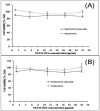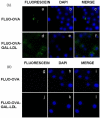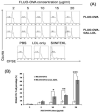Galactosylated LDL nanoparticles: a novel targeting delivery system to deliver antigen to macrophages and enhance antigen specific T cell responses
- PMID: 19637876
- PMCID: PMC2782853
- DOI: 10.1021/mp900081y
Galactosylated LDL nanoparticles: a novel targeting delivery system to deliver antigen to macrophages and enhance antigen specific T cell responses
Abstract
We aim to define the role of Kupffer cells in intrahepatic antigen presentation, using the selective delivery of antigen to Kupffer cells rather than other populations of liver antigen-presenting cells. To achieve this we developed a novel antigen delivery system that can target antigens to macrophages, based on a galactosylated low-density lipoprotein nanoscale platform. Antigen was delivered via the galactose particle receptor (GPr), internalized, degraded and presented to T cells. The conjugation of fluoresceinated ovalbumin (FLUO-OVA) and lactobionic acid with LDL resulted in a substantially increased uptake of FLUO-OVA by murine macrophage-like ANA1 cells in preference to NIH3T3 cells, and by primary peritoneal macrophages in preference to primary hepatic stellate cells. Such preferential uptake led to enhanced proliferation of OVA specific T cells, showing that the galactosylated LDL nanoscale platform is a successful antigen carrier, targeting antigen to macrophages but not to all categories of antigen presenting cells. This system will allow targeted delivery of antigen to macrophages in the liver and elsewhere, addressing the question of the role of Kupffer cells in liver immunology. It may also be an effective way of delivering drugs or vaccines directly at macrophages.
Figures







Similar articles
-
Oxidized carbon nanoparticles as an effective protein antigen delivery system targeting the cell-mediated immune response.Int J Nanomedicine. 2019 Jul 4;14:4867-4880. doi: 10.2147/IJN.S204134. eCollection 2019. Int J Nanomedicine. 2019. PMID: 31308663 Free PMC article.
-
Rational design of nanoparticles towards targeting antigen-presenting cells and improved T cell priming.J Control Release. 2017 Jul 28;258:182-195. doi: 10.1016/j.jconrel.2017.05.014. Epub 2017 May 13. J Control Release. 2017. PMID: 28511928
-
Effective induction of anti-tumor immune responses with oligomannose-coated liposome targeting to intraperitoneal phagocytic cells.Cancer Lett. 2008 Feb 18;260(1-2):137-45. doi: 10.1016/j.canlet.2007.10.038. Cancer Lett. 2008. PMID: 18077084
-
Bacterial antigen delivery systems: phagocytic processing of bacterial antigens for MHC-I and MHC-II presentation to T cells.Behring Inst Mitt. 1997 Feb;(98):197-211. Behring Inst Mitt. 1997. PMID: 9382741 Review.
-
Cooperation of liver cells in health and disease.Adv Anat Embryol Cell Biol. 2001;161:III-XIII, 1-151. doi: 10.1007/978-3-642-56553-3. Adv Anat Embryol Cell Biol. 2001. PMID: 11729749 Review.
Cited by
-
Size, shape, charge and "stealthy" surface: Carrier properties affect the drug circulation time in vivo.Asian J Pharm Sci. 2021 Jul;16(4):444-458. doi: 10.1016/j.ajps.2020.07.005. Epub 2020 Aug 29. Asian J Pharm Sci. 2021. PMID: 34703494 Free PMC article. Review.
-
Second-generation aptamer-conjugated PSMA-targeted delivery system for prostate cancer therapy.Int J Nanomedicine. 2011;6:1747-56. doi: 10.2147/IJN.S23747. Epub 2011 Aug 19. Int J Nanomedicine. 2011. PMID: 21980237 Free PMC article.
-
In Vitro Evaluation of the Biological Responses of Canine Macrophages Challenged with PLGA Nanoparticles Containing Monophosphoryl Lipid A.PLoS One. 2016 Nov 11;11(11):e0165477. doi: 10.1371/journal.pone.0165477. eCollection 2016. PLoS One. 2016. PMID: 27835636 Free PMC article.
-
Mannosylated lipid nano-emulsions loaded with lycorine-oleic acid ionic complex for tumor cell-specific delivery.Theranostics. 2012;2(11):1104-14. doi: 10.7150/thno.4525. Epub 2012 Nov 19. Theranostics. 2012. PMID: 23227126 Free PMC article.
-
Fluorescence imaging of the lymph node uptake of proteins in mice after subcutaneous injection: molecular weight dependence.Pharm Res. 2012 Jul;29(7):1843-53. doi: 10.1007/s11095-012-0708-6. Epub 2012 Feb 29. Pharm Res. 2012. PMID: 22373666
References
-
- Mackay IR. Hepatoimmunology: a perspective. Immunol. Cell Biol. 2002;80(1):36–44. - PubMed
-
- Racanelli V, Rehermann B. The liver as an immunological organ. Hepatology. 2006;43(2 Suppl 1):S54–62. - PubMed
-
- Bertolino P, McCaughan GW, Bowen DG. Role of primary intrahepatic T-cell activation in the ‘liver tolerance effect’. Immunol. Cell Biol. 2002;80(1):84–92. - PubMed
-
- Dong L, Zuo L, Xia S, Gao S, Zhang C, Chen J, Zhang J. Reduction of liver tumor necrosis factor-alpha expression by targeting delivery of antisense oligonucleotides into Kupffer cells protects rats from fulminant hepatitis. J. Gene Med. 2009;11(3):229–239. - PubMed
-
- van Rooijen N. Liposomes for targeting of antigens and drugs: immunoadjuvant activity and liposome-mediated depletion of macrophages. J. Drug Target. 2008;16(7):529–534. - PubMed
Publication types
MeSH terms
Substances
Grants and funding
LinkOut - more resources
Full Text Sources
Other Literature Sources

